Additional Pinpoints Are Not Shown – Do You Need to Worry?
Recently, a reader in the midst of shopping for a diamond proposal ring sent us an email about a couple of SI2 and VS2 diamonds he had shortlisted. One of the diamonds had a comment in the GIA report which states “Additional pinpoints are not shown”.
So he asked: “What does additional pinpoints not shown mean? Is this good or bad? Should I be concerned about it?”

Wait!!? What are the comments in the GIA report referring to?
Paul’s Answer: Pin point inclusions are basically tiny mineral crystals embedded inside the diamond. Usually, pinpoints are so minor that they won’t affect the diamond’s clarity rating when it is being graded in the lab.
The sentences “Additional pinpoints not shown” or “Pinpoints not shown” in the comments section refer to the same thing. They are written there to complete the report and to allow 3rd party appraisers to be aware of other inclusions apart from those already listed in the clarity plot.
2 Reasons Why GIA May Not Plot All Clarity Characteristics
The first reason is that these pinpoints are so tiny under 10X magnification that if they were to be plotted, they would look more severe than they are in reality. The second reason is that the pinpoints could be so numerous and widespread that it complicates the plot unnecessarily.
Here’s an example to illustrate what I mean.
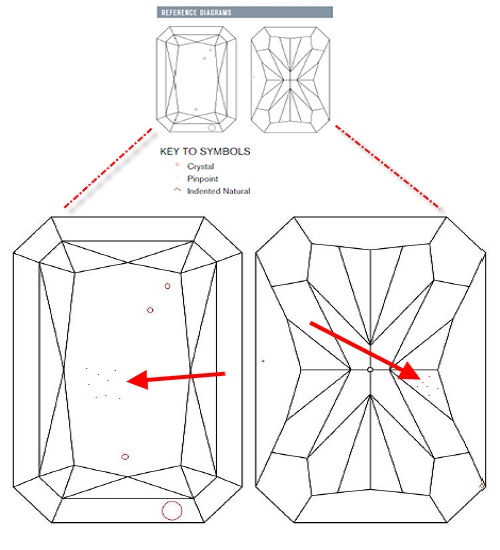
Because the inclusions are so small, you can’t even see the tiny dot on the plot unless we purposely enlarge the diagram to show it proportionately. The bottomline is, when clarity characteristics like minute pinpoints are not required to support the clarity grade or diamond identification, they may mentioned under the Comments section instead.
Would “Additional Pinpoints Not Shown” Ever Pose a Problem?
The short answer is no. Regardless of seeing this comment in a VVS or SI diamond, the pinpoints will never pose a problem. In lower clarity ratings, the grade making inclusions are never the pinpoint inclusions but other types of inclusions.
Just to be clear, pinpoint inclusions will not cause haziness, durability or eyecleanliness issues regardless of the diamond’s clarity rating. Let’s take a look at a couple of real life examples to illustrate this…
For both SI1 diamonds above, the grade making inclusions are clouds (indicated by listed order) and the pinpoints are actually extremely hard to see even under magnification. I want you to click on both listings and examine the diamonds for yourself.
And by the way, HD magnified videos like those provided by James Allen enable you to take the guesswork out of buying diamonds and visualize exactly how they look like. It offers transparency and allows you to shop with confidence.
Next, I want you to take a look at the following VVS2 diamonds and I challenge you to identify the exact locations of the pinpoints. Let me know in the comments below if you can actually see them under magnification.
Again, click on both the listings above and you will see how challenging it is to see the pinpoints. This is also why I said that pinpoints would never be an issue with eyecleanliness or pose any problems to the beauty of the stone.
To wrap things up, you don’t have to worry about comments related to pinpoints in a GIA grading report. They are the most benign type of inclusions to have in a diamond.
If you are buying slightly included (SI) or included (I) diamonds, they will have to be judged on a case by case basis as it is often the other listed inclusions that may cause issues.
Related Articles
Leave A Comment

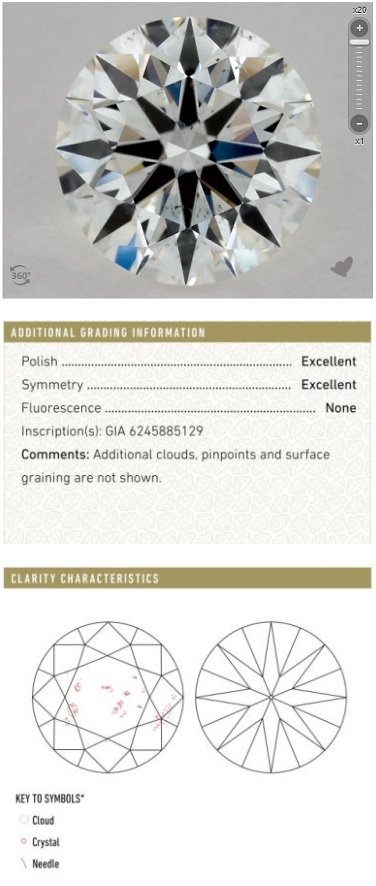
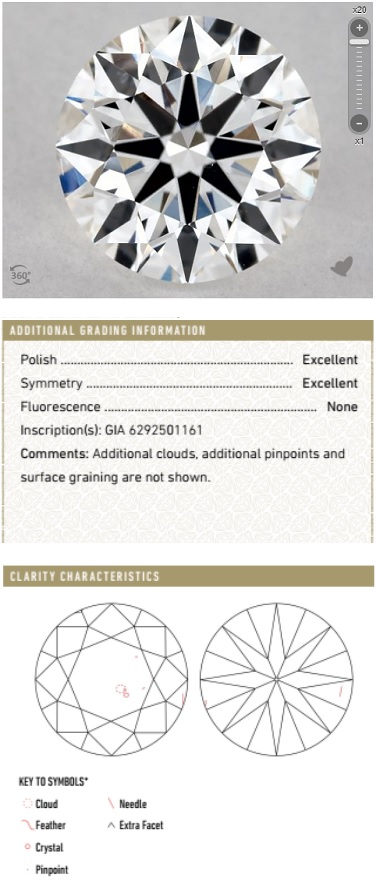
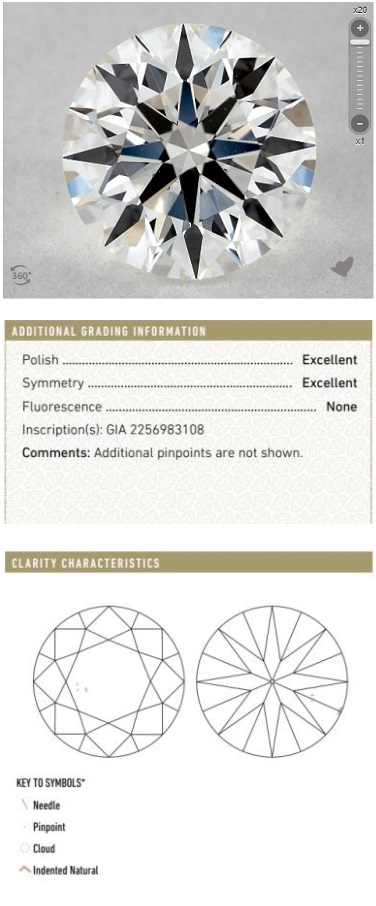
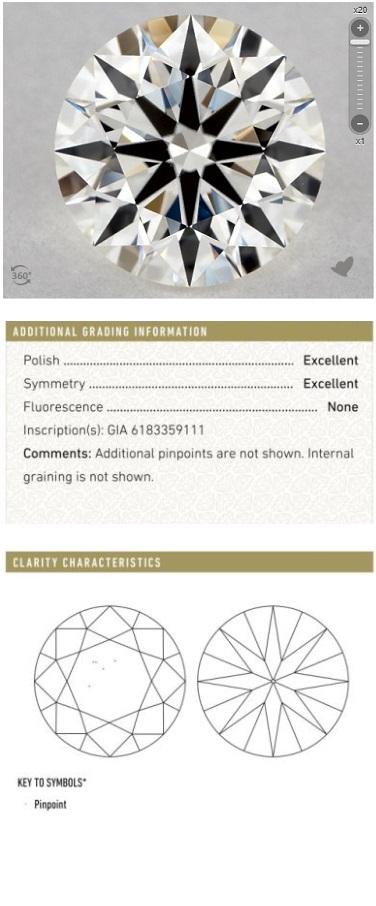
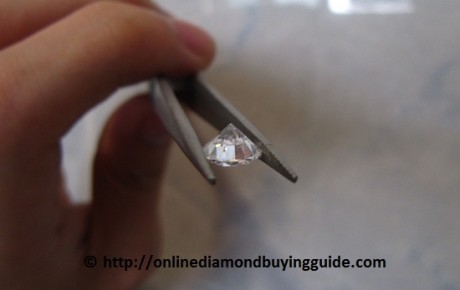
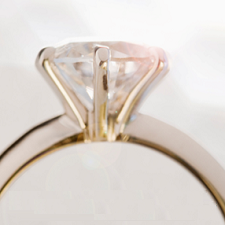
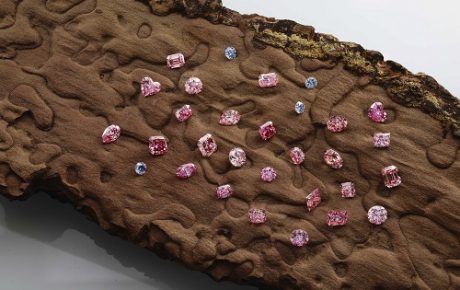
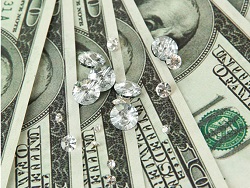









14 Comments
I just checked my certificate and it has the same exact comment here. However, it is an SI2 diamond. You mentioned that there is no cause for concern in very slightly included clarity. I am still not sure whether the GIA comment there is cause for concern in my case.
You are misplacing your worries on the wrong things. As I had said earlier, pinpoints will never be a problem with eyecleanliness, durability or haziness. It’s the other inclusions in slightly included (SI) diamonds that may matter.
I had my I VS1 1.16 ct ring upgraded to I VS2 2.06 ct with additional pinpoints per GIA and it still looks stunning. The bigger the diamond I thoughy it will be more visible but it isn’t. Also with medium fluorescence, the I color diamond looks like an H. Unless people has a loop when looking at your ring, they won’t be able to see the inclusions. My husband purchased my ring from Blue nile (www.bluenile.com) which by far has better quality diamonds and cost 20% less than most online stores and retailers. They have a clear interactive option and has more selections of diamonds. Great customer service too.
You mentioned specifically that the pin points are OK in a gia grading certificate. Is this the same for ags lab reports as well? I understand that for light performance, gia and ags does things differently and I want to know if this is the case for clarity as well.
GIA and AGS treats pin point inclusions the same way. So, it isn’t a problem with when you see pin points not shown on both types of grading reports.
I just put down a deposit for the following GIA graded report. I’ve seen the diamond and it looked good. I did before see another and nearly get it with someone else but that one had Twinning Wisps and the lady i gave the deposit to said it’s not good to have that.
So the one i’ve put £500 down on is in total £5200 including the platinum ring:
Round brilliant, measurements 6.21-6.23 x 3.79 mm
weight 0.90 carat, colour grade D, Clarity grade S12 cut excellent
polish excellent, symmetry excellent fluorescence none
comments: additional pinpoints are not shown.
Worried about the report now cos you said about pics that are too good to be true. it has one big crystal inclusion in the middle left marked with a big dollop in the picture and then just mention of pinpoint! is this OK?
the pic is like a big circle with a little crystal shape in the middle it’s not right on the top of the diamond but a little to the left in the middle. I didn’t notice it with naked eye but saw it in shop with the loop. i’ve got a video. Can you help is this a good purchase? thanks xxx
Isn’t it too late to start researching for answers after putting down a deposit? SI2s are notoriously difficult to shop for because of their inclusions. Without seeing images of videos of the diamonds, there’s no way I can give constructive advice on the diamond. Anyway, if the diamond isn’t eyeclean, what can you do with the deposit already locked into the purchase?
Understand your point about pinpoints not being problematic but what about clouds not shown? I am most concerned with brilliance, fire, sparkle, having a clean diamond that retains value and no flaws (such as feathers) that could hurt strength down the road. I believe this stone is a steal for the grading – what is your opinion? I wasn’t even considering IF, but price point was way better than other clarity (SI2, even VVS1)
https://www.bluenile.com/build-your-own-ring/diamond-details/LD13600280
Clouds not shown are typically non-issues in grades above SI1. Diamonds don’t retain value. It’s an illusion and misguided belief that jewelers spread. I’m sorry to have burst your bubble. Whether it is an IF or SI2 or D or I color diamond, don’t expect to sell it for a higher price than you paid at retail. Most diamonds above SI1 clarity will not have any inclusions that pose durability issues. IF a diamond did have flaws that will “hurt its strength”, it will be graded at an Included (I1-I3) rating.
Having said all that, I’m not sure why you are worried about clarity when you are looking at an internally flawless diamond. Now, I reviewed the diamond here:
https://www.bluenile.com/build-your-own-ring/diamond-details/LD13600280
The diamond is fairly priced and is lower in price because of its fluorescence strength. There’s nothing inherently wrong with that. I personally love very strong and strong blue fluorescence and I think it is a plus for a H color diamond. In terms of cut quality, there will be better cut stones if you look within Blue Nile’s Astor range.
Hi Paul,
I hope you can help my situation here. I handpicked my current diamond after reviewing 30 of them and thought I did enough research to make my own judgement. However, when I look closely on the side of my diamond, I can see there are a lot of pin points ( the tinest ) spreading all over the diamond. At first I thought it was finger prints or dirt but it is there after I washed it. My diamond looks crystal clear and sparkling under the regular lighting in door. But when it is under the sunlight, it doesn’t look as transparent. Should I be worry ? I hope I didn’t buy a milky stone. On the GIA certificate, it said cloud pinpoint and internal graining are not shown. This is IS1 diamond. Thank you!
It depends but I would say that the pin point and internal graining would generally not cause issues in SI1 stones. I suspect the diamond is dirty instead of looking milky because of inclusions. Do you have a video of it or the url listing?
Paul You are providing a great service for diamond buyers. 25 years my husband and I looked at diamonds in many jewelry stores through a loop seeing black very visible larger specs. We went to the premier jeweler who told us the $8000 1.5 carat was pre owned. It had two tiny specs and a feather near a prong. It was purchased and I had no idea the feather could affect the diamond if put in a new setting. For personal reasons I want to sell the ring, but I don’t think it will sell at any price if feather is explained which is the ethical way. Buyer beware!
Hi Paul,
Thanks for all those very helpfull articles! After looking at the examples you gave in this post, I went back to check the diamond I just placed the order for.
It’s VVS2, showed needles inclusion in the plot with a comment saying “pinpoints not shown”. But it had a lot more black dots spread across the diamond than any of the VVS2 with pinpoints not shown examples you gave.
I’m now a bit concerned – would this not affect the light reflection? I’m hesitating whether I need to cancel the order of this one and find another one instead.
https://www.jamesallen.com/loose-diamonds/round-cut/1.55-carat-h-color-vvs2-clarity-excellent-cut-sku-15392563
The additional pinpoints are definitely NOT an issue. I can confirm that the diamond is 100% eyeclean and the inclusions do not affect light performance.